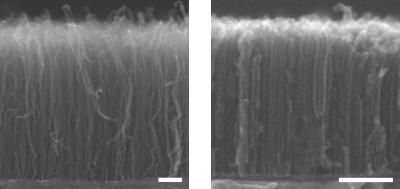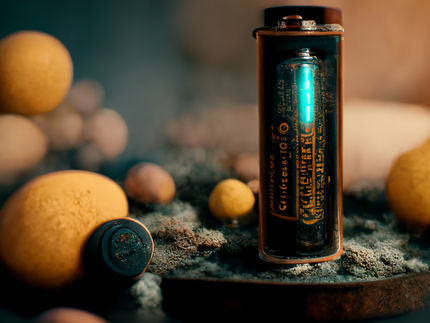Densest array of carbon nanotubes grown to date
New technique could one day help improve the performance of microelectronics in devices ranging from batteries to spacecraft
carbon nanotubes' outstanding mechanical, electrical and thermal properties make them an alluring material to electronics manufacturers. However, until recently scientists believed that growing the high density of tiny graphene cylinders needed for many microelectronics applications would be difficult.

Scanning electron microscope images are of CNT forests with low and high density.
Hisashi Sugime/U.Cambridge
Now a team from Cambridge University in England has devised a simple technique to increase the density of nanotube forests grown on conductive supports about five times over previous methods. The high density nanotubes might one day replace some metal electronic components, leading to faster devices.
"The high density aspect is often overlooked in many carbon nanotube growth processes, and is an unusual feature of our approach," says John Robertson, a professor in the electronic devices and materials group in the department of engineering at Cambridge. High-density forests are necessary for certain applications of carbon nanotubes, like electronic interconnects and thermal interface materials, he says.
Robertson and his colleagues grew carbon nanotubes on a conductive copper surface that was coated with co-catalysts cobalt and molybdenum. In a novel approach, the researchers grew at lower temperature than is typical which is applicable in the semiconductor industry. When the interaction of metals was analyzed by X-ray photoelectron spectroscopy, it revealed the creation of a more supportive substrate for the forests to root in. The subsequent nanotube growth exhibited the highest mass density reported so far.
"In microelectronics, this approach to growing high-density carbon nanotube forests on conductors can potentially replace and outperform the current copper-based interconnects in a future generation of devices," says Cambridge researcher Hisashi Sugime. In the future, more robust carbon nanotube forests may also help improve thermal interface materials, battery electrodes, and supercapacitors.
Original publication
Most read news
Original publication
Hisashi Sugime, Santiago Esconjauregui, Junwei Yang, et al., "Low temperature growth of ultra-high mass density carbon nanotube forests on conductive supports", Applied Physics Letters, 2013
Topics
Organizations
Other news from the department science

Get the chemical industry in your inbox
By submitting this form you agree that LUMITOS AG will send you the newsletter(s) selected above by email. Your data will not be passed on to third parties. Your data will be stored and processed in accordance with our data protection regulations. LUMITOS may contact you by email for the purpose of advertising or market and opinion surveys. You can revoke your consent at any time without giving reasons to LUMITOS AG, Ernst-Augustin-Str. 2, 12489 Berlin, Germany or by e-mail at revoke@lumitos.com with effect for the future. In addition, each email contains a link to unsubscribe from the corresponding newsletter.
Most read news
More news from our other portals
See the theme worlds for related content
Topic World Spectroscopy
Investigation with spectroscopy gives us unique insights into the composition and structure of materials. From UV-Vis spectroscopy to infrared and Raman spectroscopy to fluorescence and atomic absorption spectroscopy, spectroscopy offers us a wide range of analytical techniques to precisely characterize substances. Immerse yourself in the fascinating world of spectroscopy!

Topic World Spectroscopy
Investigation with spectroscopy gives us unique insights into the composition and structure of materials. From UV-Vis spectroscopy to infrared and Raman spectroscopy to fluorescence and atomic absorption spectroscopy, spectroscopy offers us a wide range of analytical techniques to precisely characterize substances. Immerse yourself in the fascinating world of spectroscopy!
Topic World Battery Technology
The topic world Battery Technology combines relevant knowledge in a unique way. Here you will find everything about suppliers and their products, webinars, white papers, catalogs and brochures.

Topic World Battery Technology
The topic world Battery Technology combines relevant knowledge in a unique way. Here you will find everything about suppliers and their products, webinars, white papers, catalogs and brochures.




























































